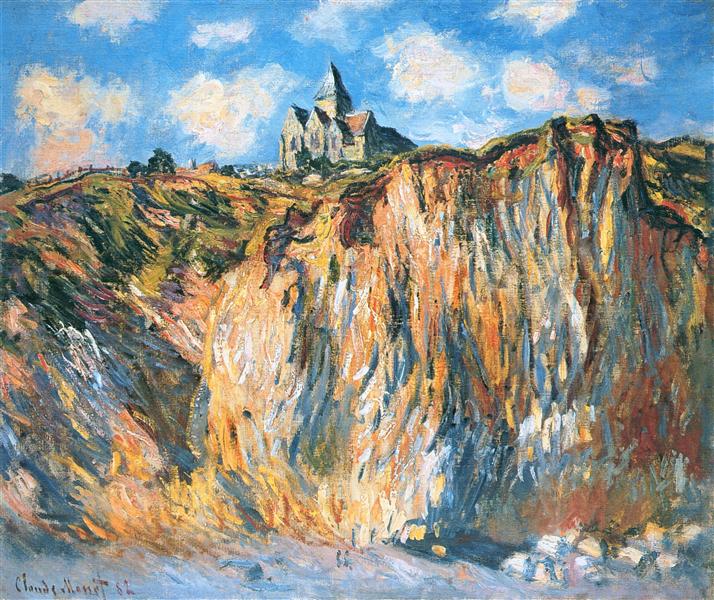Kuvaus
Claude Monetin teoksen "Varengevillen kirkko - huomenna" (1882) on taiteilijan impressionistisen mestaruuden ainutlaatuinen osoitus, joka yritti koko uransa koko uransa valon ja värin hienovaraisuudet luonnossa. Maalauksessa Monet esittelee kohtauksen Varengevillen kirkosta, paikasta lähellä Normanin rannikkoa, jossa se asui. Tämä työ on järkyttävä esimerkki sen kyvystä herättää ajan kuluminen ja muutokset kuvaustekniikan innovatiivisella käytöllä.
Koostumus on merkitty pystysuuntaisilla ja vaakasuorilla viivoilla, jotka kehystävät kirkon, korostaen sen hahmoa luonnonmaiseman edessä laajassa aamuvalossa. Rakennus sijaitsee työn keskellä, mutta enemmän kuin johtavan paikan miehittäminen, se sulautuu ympäröivään maisemaan. Kirkko on yksinkertaisella arkkitehtuurillaan maalattu harmaasävyihin, jotka ovat ristiriidassa sinisen, vihreän ja kultaa taivaasta ja maaseudusta. Monet saavuttaa tasapainon elementtien välillä, jossa rakenne ja maisema esiintyvät samanaikaisesti tuntuvissa harmoniassa.
Valo on epäilemättä maalauksen kiehtovin elementti. Monet soveltaa erilaisia lyhyitä ja löysiä harjakokeja, jotka riittävät elämään väreihin, luomalla rauhallisen aamu -ilmakehän. Auringonvalo, joka alkaa ylittää horisonttia, kylpee kohtauksen lämpimässä kirkkauudessa, rikastuttaen ympäristöä kiiltävällä ja pehmeydellä. Tämä valon mestarillinen käyttö ei vain helpota ajan visuaalista havaintoa, vaan ehdottaa myös rauhallisuuden tunnetta, joka voi seurata aamua Norman -kentällä.
Vaikka työstä puuttuu ihmishahmoja, mikä antaa sille välittömän ja hiljaisuuden ilmaa, ehdottaa niiden päivittäisten kokemusten historiaa, jotka olisivat voineet asua alueella. Kun tarkkailemalla kirkon kuollutta luonnetta niin elintärkeässä ympäristössä, voitaisiin kuvitella elämän pulssi, joka tapahtuu katsojan näkökulmasta. Tämä ihmishahmojen puuttuminen tarjoaa mietiskelutilan, joka kutsuu tarkkailijaa mietiskelemään ihmisen ja luonnon välistä suhdetta, joka on toistuva teema impressionistisessa liikkeessä.
Yhdessä "Varengevillen kirkko - huomenna" on todistus Monetin lähestymistavasta valon, värin ja lyhytaikaisen hetken sieppaamisessa. Sen löysä siveltimen tekniikka, elinvoimaisen paletin käyttö ja luonnollisen ympäristön esitys osoittavat niiden kykynsä upottaa katsojaa tietyllä hetkellä, joka on täynnä tunteita ja runoutta. Tämä teos ei edusta vain taiteilijana Monetin kehitystä, vaan heijastaa myös ajanjaksoa, jolloin impressionismi alkoi määritellä tapaa, jolla todellisuus havaittiin ja tulkitaan maalauksessa. Etsiessään valon ja maiseman ohimenevän olemuksen kaappaamiseksi Monetista tulee edelläkävijä, joka resonoi edelleen syvästi monien nykytaiteilijoiden työssä.
KUADROS ©, kuuluisa maali seinällesi.
Käsivalmistetut öljymaalaukset, ammattitaiteilijoiden laadun ja erottuvan sinetin kanssa KUADROS ©.
Kuvien jäljennöspalvelu tyytyväisyystakuu. Jos et ole täysin tyytyväinen maalauksen jäljennökseen, palautamme rahasi 100%.

